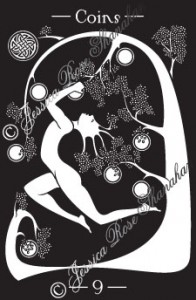
I am the fulfillment of my
desire— having sown
I reap command— command!
and I command myself—
secure as I swing— curled in—
one with the wind— sure
my fortune I have sown—
sure, assured, secure.

I am the fulfillment of my
desire— having sown
I reap command— command!
and I command myself—
secure as I swing— curled in—
one with the wind— sure
my fortune I have sown—
sure, assured, secure.
The Alchemist is the bridge between ether and life. He channels ambient power through his self and arranges it into organized forms. He demonstrates the creative power to manifest one’s desires. In this image, in the ultimate act of creation, he creates himself. First emerged, one hand directs with the magic wand. Body, limbs, moon and ether form the two loops of the sign of infinity on a field of stars. Two wispy fingers pull the tail end of his body from the mouth of the erlenmeyer flask, finishing with one hand what was begun with the other. In the most fundamental and extreme demonstration of origination, the Alchemist has brought his own self into being.
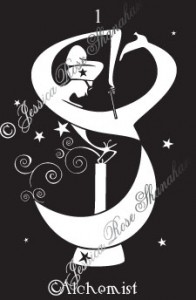
—Big Bang Theory—
Exploding past the question—
“Who Am I?”
The Alchemist comes screaming forth—
“I Am!”
Positive meaning:
Search through your bag of tricks to find creative ways to solve problems. Clear your head. Focus. You can do it!
Negative meaning:
Learn the difference between tricks and trickery. Deceit and manipulation do not make up for poor design. Stay grounded, be clear, be true.
Many years ago, an acquaintance of mine told me a dream. I like listening to dreams. I no longer remember the dream, precisely. All I remember is my impression. My impression of his dream was this image:
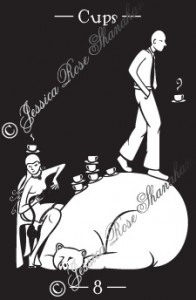
(to be read aloud, except in the case of parenthesis)
Change.
(inhale)
Let go, let go.
Fill your lungs and then let go.
(bigger inhale)
Let go, let go.
Let go, let go.
Fill your lungs, fill your lungs.
Fill your lungs and then let go.
(biggest inhale)
Let go, let go.
Let go, let go.
Fill your lungs, fill your lungs.
Fill your lungs and then let go.
Let go.
(full release)
(full inhale)
(full release)
(full inhale)
(full release)
(full inhale)
(full release)
(etc., as necessary)
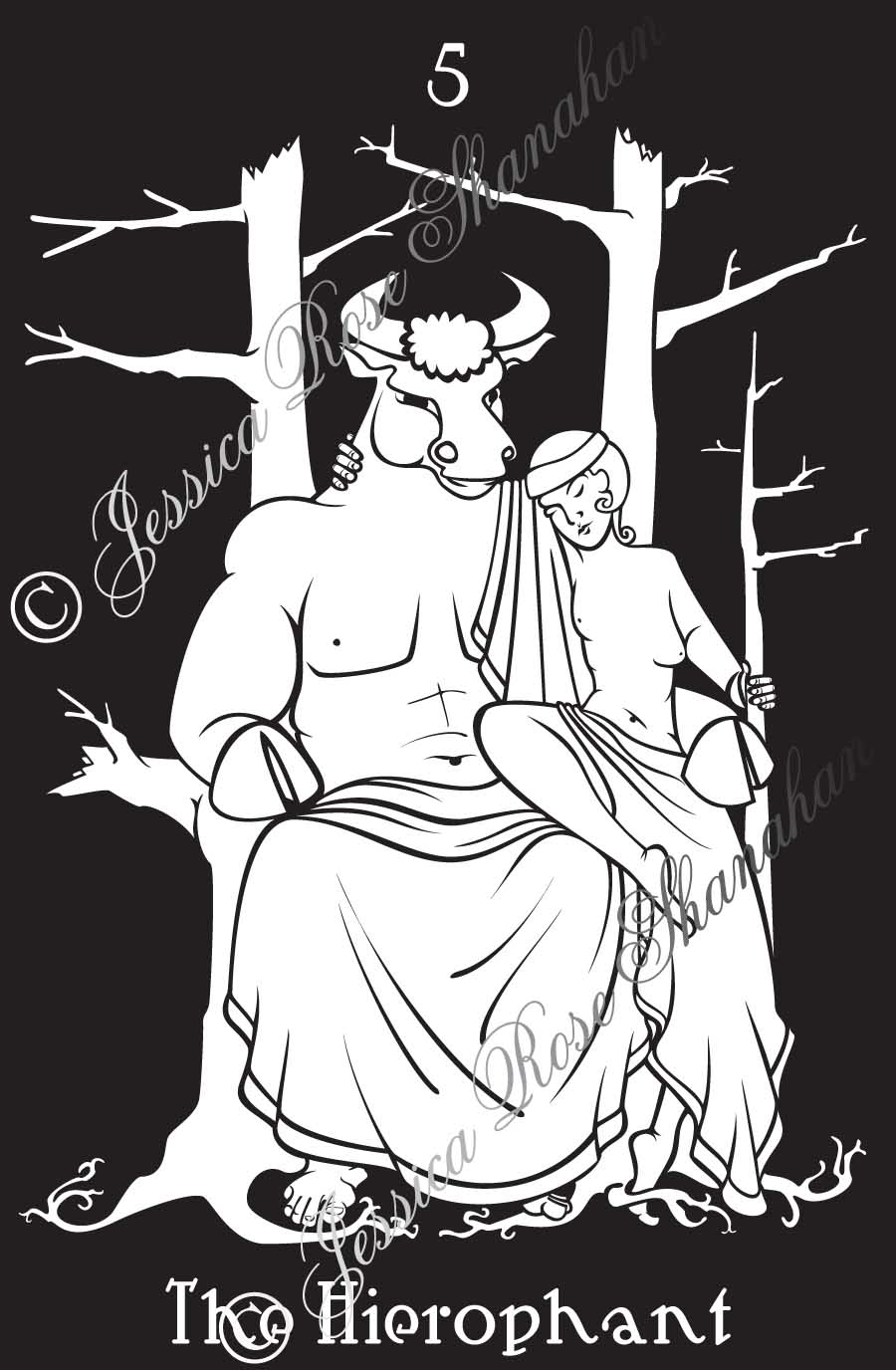 The illustration for the Hierophant commenced in a tiny cabin in Fairbanks, AK, in the midst of a love affair with Pan. Commonly known as the Greek god of wild places, shepherds and flocks, hunting, folk music, and seducer of nymphs, Pan’s origins are obscure and far older than the Olympic pantheon.
The illustration for the Hierophant commenced in a tiny cabin in Fairbanks, AK, in the midst of a love affair with Pan. Commonly known as the Greek god of wild places, shepherds and flocks, hunting, folk music, and seducer of nymphs, Pan’s origins are obscure and far older than the Olympic pantheon.
Gods exist due to our worship in one form or another. [See the moral from Dec. 6th 2013]. That which brings us closer to god— the Hierophant— is that which is able to increase our worship of god [See March 10, 2012]. My preferred form of worship is love, altho some seem to prefer fear. Thus, the illustration was to have been Pan and a nymph, which I’m sure some would have taken as devil worship. Really, the only way one can worship the devil is to place one’s self-pleasure above all else, which is what I’m supposed to have depicted in the Devil. Gods, on the other hand, take many forms. Some have crooked hairy legs and goat horns.
Although I was in love with Pan, I would have been quite happy to have been seduced by any god. Unfortunately, gods stayed away. Fortunately, muses abounded. Unfortunately, at least one of them was strong-headed. I had meant to depict the Hierophant as Pan and an adoring nymph. Somewhere along the line, my muse got ideas of her own and moved my hand to draw a bull-headed, bull-handed man reminiscent of the Minotaur.
The Minotaur is not one of many; thus, one cannot say, “a minotaur.” The Minotaur is a result of a bestial love affair between a snow-white bull and Minos’ wife Pasipha. King Minos was supposed to sacrifice the bull that Posiedon had given him, but Minos really, really liked that bull and decided to sacrifice one of his own in stead. Provoked to great annoyance, Posiedon caused Minos’ wife Pasipha fall in love with the bull. Pasipha hired Daedalus make a wooden cow for her to hide in. The bull was suitably duped— pacified, so to speak. Pasipha became pregnant. She birthed the Minotaur: the taurus (bull) of Minos, a terrifying and destructive monster. Daedalus was again called in, this time by King Minos who ordered him to design a gigantic, intricate and inescapable labyrinth in which to hide Minos’ own shame. For his efforts, Daedalus was rewarded with imprisonment, but that’s a whole other story.
My point is, despite appearances, this is not the Minotaur. My misdirected muse caused me to draw a nice, loving holy man with the head of a sacred bull. I do rather like him, myself.
[continued from yesterday’s post]
After purchasing my first deck,
I sat down to learn the meanings of the twenty-two Major Triumphs in order to compose
The Tarot Riddles.
The riddles are not intended to describe the image on the card; they are to describe the essence.
This was my first understanding of the tarot deck. It was from these riddles I began to illustrate
The Tarot of the Absurd.
Download The Tarot Riddles, print them out, cut them up, & put them in order as the Tarot of the Absurd is ordered. The first ten people who take their time to do this will earn themselves either (1) two cute little magnets OR (2) the offer of free shipping on a deck of cards/ $5 off international shipping. (Are there even ten people who read this blog?) And if you just want some cute little magnets (Strength & 7 of Cups), I’m selling business-card sized magnets for $2 each. Any questions? Anyone wanna try? Anyone? Anyone? Hey! Spread the word!
I did a woodcut print a number of years ago (to be posted in one week) called, “It was Raining Out.” In the image, a boy pulls a girl by the hand. He points to a ladder which leads to the attic. In the attic, there is a trunk. Outside, umbrellas fall like rain.
* * *
It is the attic, the endless attic where all toys go when they are outgrown, where the works of years past are laid to wait for the minds of future generations. There, the treasures are endless.
When it rains out, the boy and the girl sneak into the attic, close the door, and open an old wooden trunk, origin of all adventure. In the trunk lie the treasures of the mind, for it is filled with papers— letters, photographs, journals, cards— papers covered in writing and images.
One rainy day, the boy picks out a small carved wooden box. A box within a box. He opens it. Inside are slips of paper. On each piece, writ with fine fountain-pen script, is a terse aphorism: a riddle.
The girl takes the one on top and reads it aloud. “…”
“A riddle,” says the boy. “But what could it mean?” He takes the next, reads it. “…”
“I wonder how many there are” says the girl. She dumps the papers and arranges them in a grid on the floor to count. “Twenty-two.”
* * *
The problem was, I had no basis for filling in the ellipses. I had never seen a tarot deck. I knew there were twenty-two pictures. I knew there was a fool. I didn’t think the sixteen faces and forty numbers were actually part of the tarot deck. I had some research to do.
I went into a store that specialized in tarot decks and went through their albums of sample cards. Nothing caught my eye. They were all 78-card decks and none of them were special. At last I found a little hand-written booklet with a red lion on the cover and the words, “Twenty-Two Keys of the Tarot.” THIS was what I was looking for.
“Do you have the deck for this booklet?” I asked the clerk.
“It’s somewhere in the back,” he said, disappearing through a door beyond the bookshelves. When he returned, he handed me a small white box. “Just one,” he said. “It’s been here for ages. There’s no price on it.”
“May I look?” I asked. I was filled with that nervous sort of energy that happens when everything is absolutely right. It made my hands shake as I opened the box flap, and I was too jittery to see anything beyond the print quality (real ink on real paper) and the hand-written date. The deck was exactly 20 years old. “How much?” I asked.
“Name your price,” said the clerk.
“Ten dollars,” I said, knowing nothing about anything. I wasn’t the sort of person who bought things. The clerk nodded, rung me up, and slipped the deck into a small brown paper bag. I walked home, glowing brilliantly like the sun in the heavens.
“Tell me,” said the Young Man, “tell me.”
“Tell me of the Devil.”
“Oh, the Devil,”
spoke the Poet. “Of him I speak with foul mouth
and forked tongue. For when it comes to Devils,
who can speak the truth?”
* * *
A lone man alone, remote in his perversion,
honed in upon his own self-pleasure,
self-centered on the center of his own self,
this Devil has snagged his soul in a noose.
Hooped over in a loop, twisted and bent,
his mind and mouth deformed, reformed to form
a conjoined single-purpose pleasure apparatus
body contorted, diverged from human form,
cloistered in self-worship, his cracked mind
wanders on a twisted pleasure path,
sequestered in mad obsession of
self-consuming passion or rabid addiction
to hedonistic compulsion.
Forsaken and forsaking all society,
this Devil has found Devil’s work
for idle hands and idle mouth to do.
Chained in shackles to the conceit of his desire,
the Devil plays the Devil with himself.
I began the image for my Hierophant card long before I read Questioning the Ramayanas: a South Asian Tradition, edited by Paula Richman. If I had illustrated it afterward, the essence of the picture would have been the same, only perhaps with the poor old Shabari with her arm looped over god-king Rama’s shoulder.
Before I encountered the tarot deck, I had never heard the word “hierophant,” so I looked it up. The word comes from the greek combination of ta hiera, “the holy,” and phainein, “to show.” Traditionally, the Hierophant interprets sacred mysteries and arcane principles. I understand the Hierophant as one who demonstrates holiness and brings others closer to god.
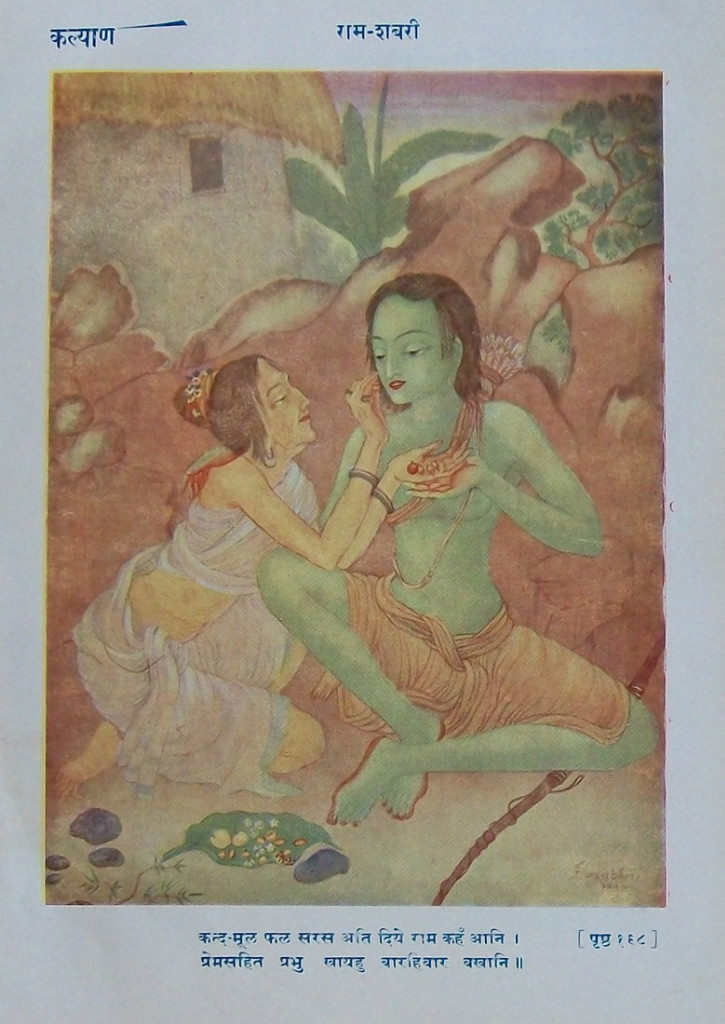
To make a very long collection of stories very short, the divine Lord Rama spends a lot of time wandering the forest in exile. One story in his wanderings concerns an old woman named Shabari.
Shabari is a low-caste woman who has escaped marriage and exiled herself to the edge of a community of forest-dwelling ascetics. She keeps herself hidden. At night she sweeps the paths an deposits firewood outside the doors of their hut and the men say, “Who has done this?”
Their Guru instructs his students to stay awake and apprehend this “thief” who is stealing their merit. So they capture Shabari, who falls at the Sage’s feet in devotion. The Sage realizes she something special and invites her into the ashram. The aesthetics take offense at this. When the Guru dies, he promises Shabari that she will see Lord Rama in her lifetime. Disconsolate, it is this knowledge that keeps her alive.
With their Guru gone, the aesthetics get nasty. When one accidentally brushes Shabari as she is sweeping the path to the lake, he berates her for polluting him. When he gets to the lake, he finds it has become polluted with blood and vermin. He blames it on that unlucky woman Shabari instead of his own unclean actions.
Every day Shabari spends a great amount of time collecting wild jujube fruit from the forest to serve to Lord Rama in case he should happen to stop by. Jujube are uncultivated. Some are very sweet & some are quite sour, so Shabari tastes each one to make sure it is sweet. Only the sweetest for the God-King! In Hindu tradition, there are clean foods and there are dirty foods. A food tasted by a woman, and a low-caste woman at that, is excessively dirty.
Every day she waits, but when she finally hears he is coming, she hides in her hut. Of course he seeks her out. She prostrates before him; he lifts her up. Her sorrow departs and she feeds him fruit. He eats and praises it.
Meanwhile all the aesthetics are worried about the polluted lake. Someone suggests they ask Rama for a solution when he gets there. Oh, they learn he is already there, and sitting in the hut of that woman!
Their pride is shattered. They go to the hut. Rama instructs to the men to touch Shabari’s feet (yuk! dirty!) and bring her to the lake. When she touches the lake, it is once again clean.
This story challenges all Hindu concepts of purity and pollution, ultimately showing that the purest thing is unsullied devotion. The god-king Rama has visited Shabari first not because she follows all those strict rules of being— the highest of which is being a man of high birth— but because she is the most devoted.
The moral of my retelling is this: That which brings one closer to god is not following arcane rules and mysteries, but unwavering devotion and love demonstrated through thought and action. Gods love best those who love them best.
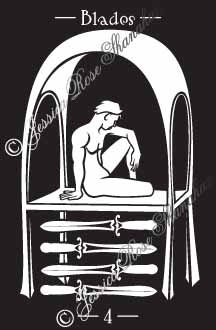
Positive:
Rash action oft’ builds to swift retribution;
meditation can lead to a peaceful a solution.
Negative:
Standing too long in mute contemplation
leads one from inaction to putrid stagnation.
Neutral:
A case of gunpowder-filled lead ammunition
is shot at the ghost of a thought. No fruition.
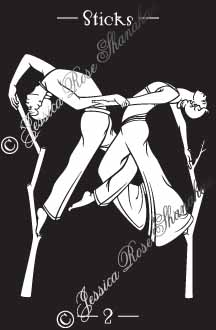 Well favored, the Two of Sticks is about planning, progress, decisions and discovery. With such careful steps and the courage to attempt something less than comfortable, these two dancers have managed to find stability and freedom in an apparently precarious pose.
Well favored, the Two of Sticks is about planning, progress, decisions and discovery. With such careful steps and the courage to attempt something less than comfortable, these two dancers have managed to find stability and freedom in an apparently precarious pose.
Ill favored, with poor planning, these two dancers start to tremble, upsetting their delicate balance. As the future quickly becomes uncertain, they must make a hasty plan to dismount.
I am feeling stuck. I have no plan. I feel as if my balance depends upon a partner whose next move is unknown by anyone but the omniscient. I feel stuck in this posture. Although it is where I want to be, my inability to make a plan makes it seem as if I fail to accomplish anything, ever.
I could blame failure of accomplishment on the fact that my baby doesn’t nap without me by her side or holding her, but that seems a cop-out. She’s so cute! How can I blame anything on her? I would rather blame it on the fact that I fail to use my time wisely and I don’t plan anything successfully. Especially not naps.
I would like to write a cohesive companion book for this deck. What are the steps I need to take in order to be able to do this successfully? What’s the plan, Shanahan?